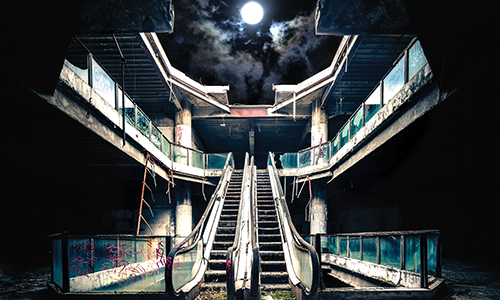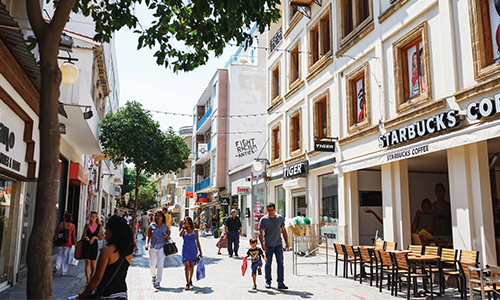Is the era of the mall over? In the United States, the country responsible for making shopping malls so ubiquitous, these megastructures are increasingly coming under pressure.
A 2015 report by Green Street Advisors, a real estate and real estate investments trust analytics firm in the US, stated that about 25 malls had closed in the last four years. It also said that 60 malls were on the verge of closing.
What’s causing this? A big problem is the fact that once-dominant stores such as Sears, Macy’s and JC Penney are closing down. These anchor stores are disappearing, and malls are struggling to find replacements that can drive traffic and occupy gigantic retail spaces.
The birth of the outlet mall
Another concern is the rise of the outlet mall. What is an outlet mall, you ask? Two things define an outlet mall. Firstly, these malls tend to look very different from traditional malls.
Instead of large and expensive structures situated in the heart of cities, outlet malls are more basic open-air centres that can be found in the outskirts of cities. This means, quite obviously, that rent is much lower, which is what attracts retailers.
And what attracts shoppers? Cheap products. Outlet malls deal exclusively in affordably-priced fare. Importantly, though, we’re not talking about cheap knockoffs of big brands. No, outlet malls sell cheaper versions of goods from established and respected brands. Gucci, Prada, Hilfiger — these are the kinds of brands you can find at an outlet mall.
These shops might sometimes sell end-of-range or rejected goods, but this isn’t what they focus on.
They sell products that have been made cheaper specifically to be sold in an outlet mall — not massively cheaper, just slightly less ornate. A shirt, for example, might not boast as much embroidering as one found in a regular store.
The state of the economy

It isn’t difficult to understand why outlet malls are becoming so popular: Both companies and consumers are under economic pressure, so cheaper ways of buying and selling goods seem increasingly attractive.
Since the global economy in general (and the US economy in particular) took a nosedive in 2008, outlet malls have been springing up like mushrooms. While traditional malls are struggling, the number of outlet malls is growing, and not only in the United States, but in other countries as well.
China in particular has embraced outlet malls. Up until a few years ago, luxury brands were enjoying tremendous sales growth (about 20% to 30% year on year) in the country.
That growth has now plateaued completely, at least as far as traditional channels are concerned. Luxury brands are seeing great success in outlet malls, though. The majority of brands are reporting same-store sales increases of 30% – 40%.
Since it’s unlikely that the economy will return to pre-2008 levels anytime soon, the popularity of outlet malls is sure to grow.
Speaking at the FNB Franchising Leadership Summit towards the end of 2015, Pareto Limited CEO Marius Muller stated that he believed outlet malls will make their way to South African shores as well. In fact, we’re already seeing small-scale outlet malls being established locally.
Food, friends and fun
As people spend less time at shopping malls, restaurants are becoming crucial to increasing the time shoppers spend hanging around. More than ever, people love spending time at trendy restaurants, eating delicious food.
One need only examine the popularity of a restaurant franchise such as Tasha’s and a casual-dining operation such as RocoMama’s.
In order to capitalise on this, malls are being forced to rethink their food courts. Cheap and quick food is no longer good enough. While fast-food businesses remain important within the mall context, sit-down restaurants that offer a relaxing environment are equally important. Shoppers no longer simply want to eat on the run – they want a place where they can meet up with friends, have fun and eat good food.
Redesigning the shopping mall

And what about traditional shopping malls? Muller, whose Pareto Limited is responsible for large and successful local malls such as Cresta, Sandton City, Menlyn Park and The Pavilion, sees the food court as crucial to the long-term survival of the traditional mall.
“People aren’t really spending less money at malls,” said Muller at the summit. “But they are spending less time there, and they are visiting less frequently.
“In order to ensure that people spend more time in malls, we need to focus on the food areas. Food has become a huge focus for many people. People socialise by eating out at restaurants. Malls need to position themselves as great places to meet up with friends and enjoy a good meal.”
With this in mind, Pareto is currently busy upgrading the food courts of both Menlyn Park and Cresta.
Muller also believes that the overall design of malls need to be simplified and toned down. For a while, just about every new mall was themed by giving it a Tuscan or other similar design. Now malls are being built (or refurbished) to look clean, open and very minimalist in nature.
“The design of the mall should not take attention away from the stores. The aim, ultimately, is to allow stores to attract customers, which is why malls should be simple in look and feel. The focus should always be on the stores and what they’re selling,” said Muller.








